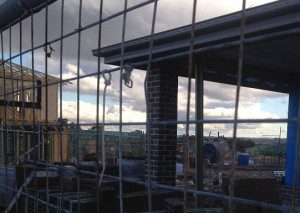
Campbelltown Council says it is confident a planned massive population growth will ensure it is fit for the future as a stand alone entity.
This will be the essence of its response to the State Government in the wake of having been found not fit for the future by the Independent Pricing and Regulatory Tribunal (IPART).
Council says that an estimated 53,000 new homes and more than 200,000 more residents by 2036 will mean a massive boost to its revenues and help it secure its future.
While Campbelltown Council was found to have failed to meet the fit for the future financial criteria, IPART said it did satisfy the scale and capacity criteria.
Which means it can stand alone going forward if it can convince IPART and the Baird government it has a sound financial plan.
The Mayor, General Manager and Director Business Services have already met with the Minister for Local Government, Paul Toole to discuss the IPART assessment.
It was agreed that council’s response to the IPART assessment should demonstrate Council’s increased capacity to meet the financial benchmarks via increased dwelling and subsequent population numbers and the increasing capacity to provide local employment opportunities.
A report tabled at council’s meeting last Tuesday says that this growth, and additional infrastructure improvements, will be achieved via the establishment of the Glenfield to Macarthur Growth Corridor (a draft strategy for which has recently been exhibited for public comment) and the Greater Macarthur Urban Investigation Area (for which a preliminary land release strategy has been prepared and is currently on public exhibition).
“Together, these strategies are proposed to result in at least an additional 33,100 dwellings within the Campbelltown Local Government Area (LGA) with an estimated population increase of over 93,500 persons by 2036.
The Corridor Strategy estimates creation of an additional 20,700 jobs within the urban corridor area, while the Land Release Strategy identifies an additional 65,000m2 of gross floor area for employment lands by 2036.
The predicted growth in both housing and employment will attract additional funding and infrastructure provision, as well as additional revenue from rates and Section 94/Planning Agreement levies.
In addition to the growth identified in the recently announced strategies, a number of growth centres are currently under construction.
These are facilitated via the Major Projects and Growth Centres SEPPs (State Environmental Planning Policies) and include Edmondson Park South and East Leppington.
The Western Sydney University residential precinct and the urban renewal areas of Claymore and Airds Bradbury will also accommodate additional residential growth and collectively yield approximately 20,000 dwellings.
When combined, the overall expected additional dwelling yield is approximately 53,000 by 2036, the report said.
The resultant overall population for the Campbelltown LGA is therefore estimated to be 365,000 persons by 2036 (the current population is 155,915).

Given the potential growth of revenue as it relates to these development opportunities, and the potential revitalisation of the Campbelltown CBD, council can substantiate a case to meet the sustainability benchmarks as it relates to the operating performance ratio and therefore be fit and sustainable as a stand alone local government authority.
The Department, Premier and Cabinet have forwarded a template to all councils to develop a response to the assessment by IPART.
The format of the template is a short response for those councils that meet the scale and capacity criteria on options for council to provide additional information to stand alone, the report said.
The body of this report will form the basis of council’s response in enhancing its financial sustainability and reinforcing council’s capacity to stand alone.
Alternatively for those councils that do not meet scale and capacity, the template requests those councils to indicate the options they consider preferable in merger proposals.
Campbelltown Council says will provide a response to the Department of Premier and Cabinet by November 18 which reinforces its improvement proposal to stand alone.
The objectives of the Fit for the Future reforms, which got under way 13 months ago, were to ensure councils have the scale and capacity to meet community needs into the future, are financially sound, operating efficiently and in a strong position to guide community growth and deliver quality services.
Two years earlier, in 2013, the Independent Local Government Review Panel (ILGRP) was tasked to review and formulate options for a stronger and more effective system of local government.
The Fit for the Future reforms required councils to assess their current and forecast performance against criteria and provide a submission to the government by June 30 this year.
As a council recommended by the ILGRP to stand alone, Campbelltown was required to develop an improvement proposal to demonstrate how council currently meets or will improve its financial performance against the financial benchmarks to become fit for the future, the report said.
The framework templates provided by the Office of Local Government assessed council’s scale and capacity and financial performance using criteria that measured sustainability, efficiency, and infrastructure management.
Campbelltown City Council’s improvement proposal was submitted to the Independent Pricing and Regulatory Tribunal (IPART) on June 30.
IPART has assessed Council’s submission on behalf of NSW Government and prepared a final report on the assessment of all council proposals for Fit for the Future.
The results of the IPART assessment have been publicised to the wider community and has currently identified that Campbelltown City Council do not meet the sustainability criteria as it relates to the operating performance ratio.
The document states as follows: “Councils assessed as not fit due to not meeting the financial criteria.
“We assessed three Council Improvement Proposals in Metropolitan Sydney as not fit because they did not demonstrate they met the financial criteria overall. These councils are all in outer metropolitan Sydney, Blacktown City Council, Campbelltown City Council and Hawkesbury City Council.
“[social_quote duplicate=”no” align=”default”]As these councils were assessed as satisfying the scale and capacity criterion, strategies to improve their financial performance should enable them to become fit. This could include measures to promote financial sustainability, by reducing costs and increasing revenues.’’[/social_quote]
However, the strategies that could be adopted will depend on each council’s circumstances and the Government’s priorities.
It is also important to highlight that in the IPART assessment that Council satisfies the scale and capacity criteria.
Within this part of the document it is noted ‘our analysis has not identified evidence for a better alternative for the Council’s proposal to stand-alone’.
This highlights that the recommendation of the ILGRP and IPART that the best outcome for Campbelltown City Council is to stand alone.
♦ Liverpool Council, which has been holding talks with neighbouring councils since it also found out it was not fit for the future, will decide its response to IPART at an extraordinary meeting to be held on Tuesday, November 10 from 6pm.




“Given the potential growth of revenue as it relates to these development opportunities, and the potential revitalisation of the Campbelltown CBD, council can substantiate a case to meet the sustainability benchmarks as it relates to the operating performance ratio and therefore be fit and sustainable as a stand alone local government authority.”
Given this – and if it is true – the question must surely be asked: why did Council not put a full and substantive case to IPART in the first place?